Python - 八大排序算法
1、序言
本文使用Python实现了一些常用的排序方法。文章结构如下:
1.直接插入排序
2.希尔排序
3.冒泡排序
4.快速排序
5.简单选择排序
6.堆排序
7.归并排序
8.基数排序
上述所有的排序均写在一个Python自定义类中,作为成员函数。
2、排序方法详细介绍
1.直接插入排序
直接插入排序(Straight Insertion Sort)是一种最简单的排序方法,它的基本操作是一个值插入到已排好序的有序表中,从而得到一个新的、记录数增1的有序表。如下图所示:

由上图可知若最初始的有序表即为数组的第一个元素。用Python实现如下:
def straight_insertion_sort(self, value_list):
"""
直接插入排序
:param value_list: 无序列表
:return:
"""
return self.__straight_insert(value_list) @staticmethod
def __straight_insert(value_list):
sorted_list = []
sorted_list.append(value_list.pop(0))
for i in range(0, len(value_list)):
tail = True # 是否在尾部插入
insert_loc = 0
for j in range(len(sorted_list)):
if value_list[i] <= sorted_list[j]:
tail = False
insert_loc = j
break
sorted_list.append(value_list[i]) # 先将值插入尾部
if not tail:
# 移动值
for j in range(len(sorted_list) - 1, insert_loc, -1):
temp = sorted_list[j]
sorted_list[j] = sorted_list[j - 1]
sorted_list[j - 1] = temp
return sorted_list
2.希尔排序
希尔排序(Shell’s Sort)又称“缩小增量排序”(Diminishing Incerement Sort),它也是一种数插入排序的方法,但在时间效率上较前面的排序方法有较大的改进。它的基本思想是:先将整个待排记录序列分割成若干个子序列分别进行直接插入排序,待整个序列中的记录“基本有序”时,再对全体记录进行一次直接插入排序。如下图所示:
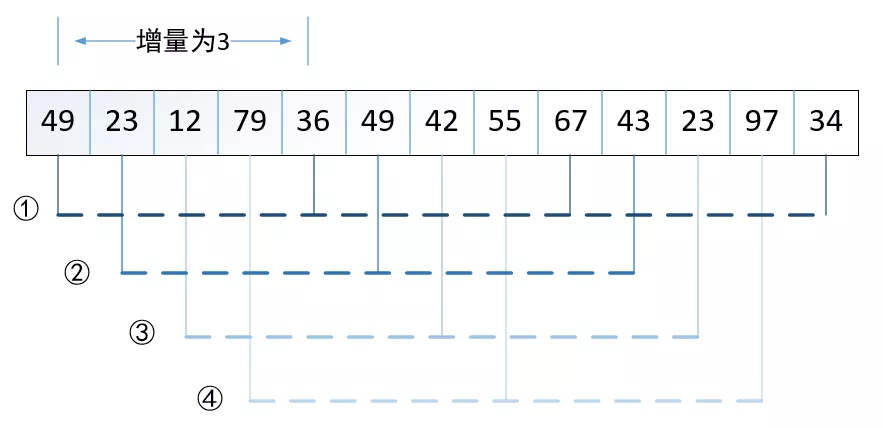
即根据增量将原序列分割成多个子序列进行直接插入排序。增量应不断减小,且最后一个增量为1。用Python实现如下:
def shells_sort(self, value_list):
"""
希尔排序
:param value_list: 待排序的无序列表
:return: 排序后的列表
"""
gap = len(value_list) // 2
while gap >= 1:
i = 0
while(i + gap) < len(value_list):
start = i
gap_list = []
while start < len(value_list):
gap_list.append(value_list[start])
start = start + gap
gap_list = self.__straight_insert(gap_list)
start = i
while start < len(value_list):
value_list[start] = gap_list.pop(0)
start += gap
i += 1
gap //= 2
sorted_list = value_list
return sorted_list
3.冒泡排序
冒泡排序(Bubble Sort)的过程很简单。首先将第一个记录的关键字和第二个记录的关键字进行比较,若逆序(与需要的顺序相反),则将两个记录交换之,然后比较第二个记录和第三个记录的关键字,以此类推。为第一趟冒泡结束,接着对前n-1个记录继续进行上述的过程。这样重复的过程直至n-1=1结束。排序过程如下所示:

用Python实现如下:
@staticmethod
def bubble_sort(value_list):
"""
冒泡排序
:param value_list: 待排序的无序列表
:return: 排序后的列表
"""
for i in range(len(value_list) - 1):
for j in range(i + 1, len(value_list)):
if value_list[i] > value_list[j]:
value_list[i], value_list[j] = value_list[j], value_list[i]
sorted_list = value_list
return sorted_list
4.快速排序
快速排序(Quick Sort)是对冒泡排序的一种改进。它的基本思想是,通过一趟排序将待排记录分割成独立的两部分,其中一部分记录的关键字均比另一部分记录的关键字小,则可分别对这两部分记录继续进行排序,已达到整个序列有序。其排序思想如下:
首先任意选取一个记录(通常可选第一个记录)作为枢轴,然后按下述原则重新排列记录:将所有关键字较它小的记录都安置在它的位置之前,将所有关键字较它大的记录都安置在它的位置之后。一趟快速排序的具体做法是:设两个指针low和high,他们的初值分别为最低位置的下一个位置和最高位,设最低位置枢轴的关键字为pivotkey,则首先从high所指位置起向前搜索找到第一个关键字小于pivotkey的记录的枢轴记录互相交换。发生了交换后才从low所指向的位置起向后搜索,找到第一个关键字大于pivotkey的记录和枢轴记录互相交换。重复这两步直至low=how为止
如下图所示:

特别要注意换方向的时机是发生了交换后,用Python实现如下:
def quick_sort(self, value_list):
"""
快速排序
:param value_list: 待排序的无序列表
:return: 排序后的列表
"""
low = 0
high = len(value_list) - 1
self.__qsort(value_list, low, high)
sorted_list = value_list
return sorted_list def __qsort(self, val_list, low, high):
"""
快速排序辅助函数
:param val_list: 无序列表
:param low: 低位
:param high: 高位
:return:
"""
if low >= high:
return
pivot_key = low
temp_low = pivot_key
temp_high = high
while low < high:
# 分成一边比轴(pivot)大,一边比轴(pivot)小的顺序
while low < high:
if val_list[high] < val_list[pivot_key]:
temp = val_list[high]
val_list[high] = val_list[pivot_key]
val_list[pivot_key] = temp
pivot_key = high
break # 发生交换后,就换方向
else:
high -= 1
while low < high:
if val_list[low] > val_list[pivot_key]:
temp = val_list[low]
val_list[low] = val_list[pivot_key]
val_list[pivot_key] = temp
pivot_key = low
break # 发生交换后,就换方向
else:
low += 1
self.__qsort(val_list, temp_low, pivot_key - 1)
self.__qsort(val_list, pivot_key + 1, temp_high)
5.简单选择排序
选择排序(Selection Sort)是一种简单直观的排序算法。它的基本思想是:每一趟在n-i+1(i=1,2,...,n-1)个记录中选取关键字最小的记录作为有序序列中第i个记录。简单选择排序:通过n-1次关键字的比较,从n-i+1个记录中选出关键字最小的记录,并和第i(1≤i≤n)个记录交换之。如下图所示:
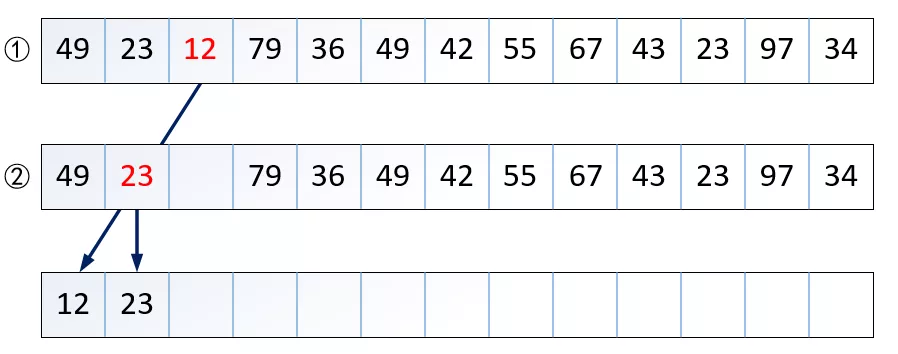
用Python实现如下:
@staticmethod
def simple_selection_sort(value_list):
"""
简单选择排序
:param value_list: 待排序的无序列表
:return: 排序后的列表
"""
for i in range(len(value_list)):
min_val = 9999999
for j in range(i, len(value_list)):
if min_val > value_list[j]:
min_val = value_list[j]
count = 0 # 如果有多个相同的最小值
for j in range(i, len(value_list)):
if min_val == value_list[j]:
value_list[j], value_list[i + count] = value_list[i + count], value_list[j]
sorted_list = value_list
return sorted_list
6.堆排序
堆排序(Heap Sort)是指利用堆这种数据结构所设计的一种排序算法。堆的定义如下:
n个元素的序列{k1,k2,...,kn}当且仅当满足一下关系时,称之为堆。

若将序列看成是一个完全二叉树,则堆的含义表明,完全二叉树中所有非终端节点均不大于(或不小于)其左、右孩子节点的值。由此,若序列是堆,则堆顶元素必为序列中的最小值(或最大值)。如下图所示:
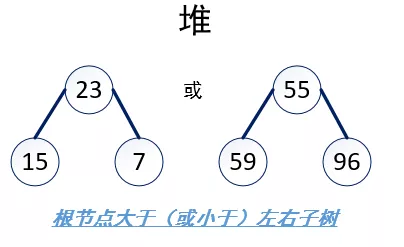
至此,我们可以给出堆排序的过程:若在输出堆顶的最小值后,使得剩余n-1个元素的序列又建成一个堆,则得到n个元素中的次小值。如此反复执行,便能得到一个有序序列。
故整个堆排序可以大致分为两个过程:
·将无序序列建成堆。
·输出堆顶元素后,用类似建堆的方法调整堆。
如下两个图所示:
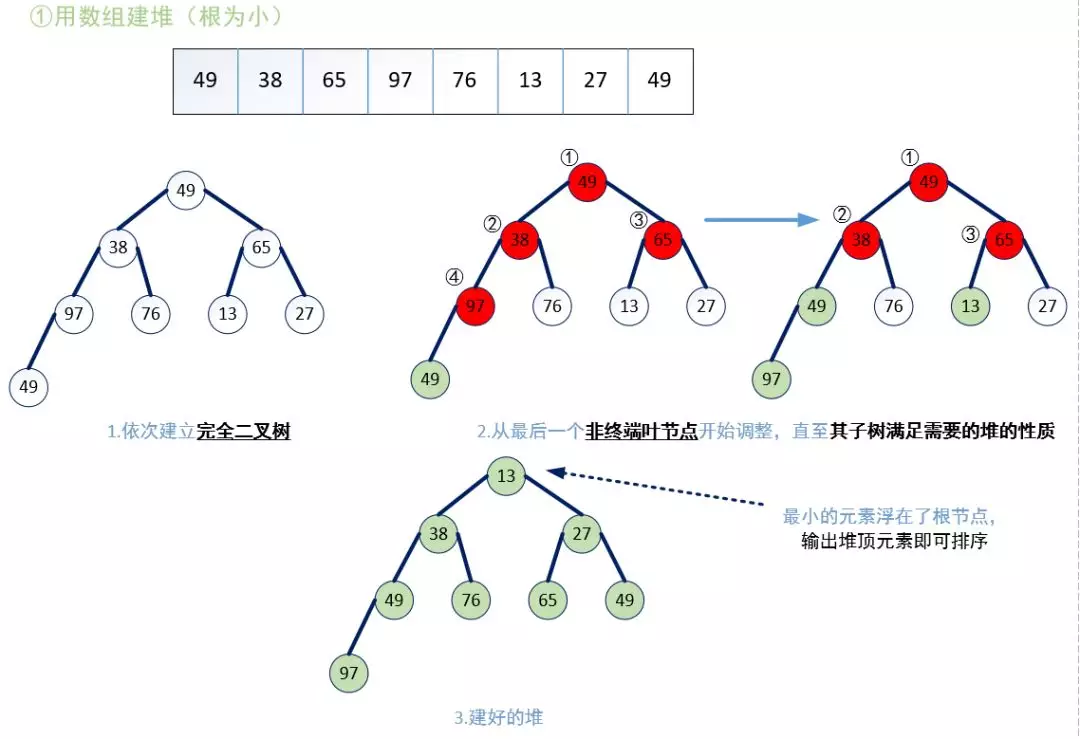

根据堆排序的特点总结出两点注意事项:
1.利用把堆看成完全二叉树的特点,用完全二叉树的性质解决算法问题。
2.建堆的过程是从树种的最后一个非终端节点逆序开始调整的。
3.每调整一次需要检查前后是否依然保持堆的特征。
本文利用了二叉树的孩子兄弟表示法来生成二叉树(堆)的。代码如下:
class CldSibNode(object):
"""
私有内部类:孩子兄弟二叉链表节点
""" def __init__(self, val):
self.value = val
self.child = None
self.sibling = None def heap_sort(self, value_list):
"""
堆排序
:param value_list: 待排序的无序列表
:return: 排序后的列表
"""
sorted_list = []
root_node = self.CldSibNode(None)
self.__child_sibling(root_node, value_list, 0)
for ct in range(1, len(value_list) // 2 + 1): # 建堆
self.__adjust_heap(root_node, len(value_list) // 2 + 1 - ct, 1)
for i in range(1, len(value_list) + 1): # 堆排序
sorted_list.append(root_node.value) # 输出堆顶元素
head = root_node
self.__shrink_heap(root_node, len(value_list) + 1 - i, 1, head)
self.__adjust_heap(root_node, 1, 1) # 调整堆 return sorted_list def __child_sibling(self, node, value_list, ind):
"""
创建完全二叉树的左孩子右兄弟二叉链表
:param node: 当前节点
:param value_list: 待排序的无序列表
:param ind:
:return:
"""
if ind >= len(value_list):
return
node.value = value_list[ind]
if ind * 2 + 1 < len(value_list):
node.child = self.CldSibNode(None) # 孩子
self.__child_sibling(node.child, value_list, ind * 2 + 1)
if ind * 2 + 2 < len(value_list):
node.child.sibling = self.CldSibNode(None) # 兄弟
self.__child_sibling(node.child.sibling, value_list, ind * 2 + 2) def __adjust_heap(self, root_node, last_ind, now_ind):
if not root_node or not root_node.child: # 不为空且有孩子
return
if now_ind == last_ind:
# 需要调整的非终端节点
temp = root_node
cg = False
while temp.child:
if temp.value > temp.child.value:
temp.value, temp.child.value = temp.child.value, temp.value
cg = True # 发生交换
if temp.child.sibling:
if temp.value > temp.child.sibling.value:
if cg:
# 如果发生过交换
temp.value, temp.child.value = temp.child.value, temp.value
temp.value, temp.child.sibling.value = temp.child.sibling.value, temp.value
temp = temp.child.sibling
continue
else:
if cg:
# 如果发生过交换
temp = temp.child
continue
break
# 递归
self.__adjust_heap(root_node.child, last_ind, now_ind * 2)
if root_node.child.sibling:
self.__adjust_heap(root_node.child.sibling, last_ind, now_ind * 2 + 1) def __shrink_heap(self, root_node, last_ind, now_ind, head):
if not root_node or now_ind * 2 > last_ind:
# 为空
return
if last_ind == now_ind * 2 + 1:
head.value = root_node.child.sibling.value
root_node.child.sibling = None
return True
if last_ind == now_ind * 2:
head.value = root_node.child.value
root_node.child = None
return True
if root_node.child:
self.__shrink_heap(root_node.child, last_ind, now_ind * 2, head)
self.__shrink_heap(root_node.child.sibling, last_ind, now_ind * 2 + 1, head)
7.归并排序
归并排序(Merging Sort),“归并”的含义是将两个或两个以上的有序表组合成一个新的有序表。假设初始序列有n个记录,则可看成是n个有序的子序列,每个子序列的长度为1,然后两两归并,得到[n/2]个长度为2或1的有序子序列;再两两归并,……,如此重复,直至得到一个长度为n的有序序列为止,这种排序方法为2-路归并排序。算法的基本思想如下图所示:
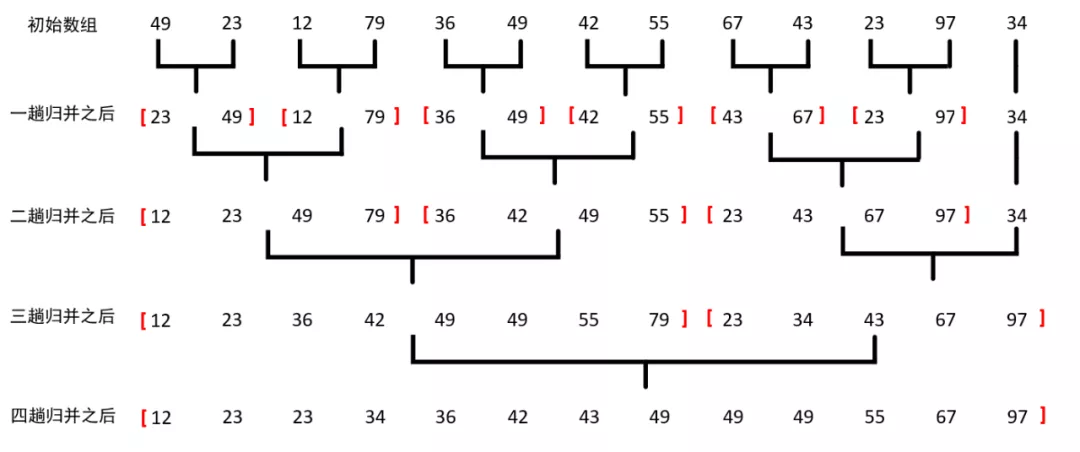
其中两个子序列的合并大有学问,基本思想就是:分别在两个序列头设置指针,比较两个序列指针所指的值的大小,将满足要求的值提取出来形成新列表,并将指针右移。当其中一个指针指向结尾之后时,表示其中一个列表已取尽,接着直接在新列表尾部连接另一个列表。如下图所示:
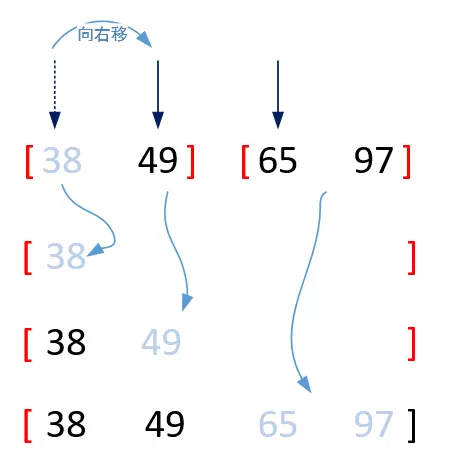
用Python实现如下:
@staticmethod
def merging_sort(self, value_list):
"""
归并排序
:param value_list: 待排序的无序列表
:return: 排序后的新列表
"""
i = 0
while np.power(2, i) < len(value_list):
count = np.power(2, i)
start = 0
outer_temp = []
while start < len(value_list):
# 定位另一边
other = start + count
temp = []
if other >= len(value_list):
# 另一边不存在:直接合并
outer_temp.extend(value_list[start: start + count])
break
left, right = 0, 0
while left < count or right < count:
if other + right >= len(value_list):
# 右边提前结束
temp.extend(value_list[start + left: start + count])
break
elif value_list[start + left] < value_list[other + right]:
# 左边更小
temp.append(value_list[start + left])
left += 1
if left == count:
# 左边遍历结束
temp.extend(value_list[other + right: other + count])
break
else:
# 右边更小
temp.append(value_list[other + right])
right += 1
if right == count:
# 右边遍历结束
temp.extend(value_list[start + left: start + count])
break
outer_temp.extend(temp)
start += count * 2
value_list = outer_temp
i += 1
sorted_list = value_list
return sorted_list
8.基数排序
基数排序(Radix Sort)是一种非比较整数排序算法,其原理是将整数按位数切割成不同的数字,然后按每个位数分别比较。由于整数也可以表达字符串(比如名字或日期)和特定格式的浮点数,所以基数排序也不是只能使用于整数。
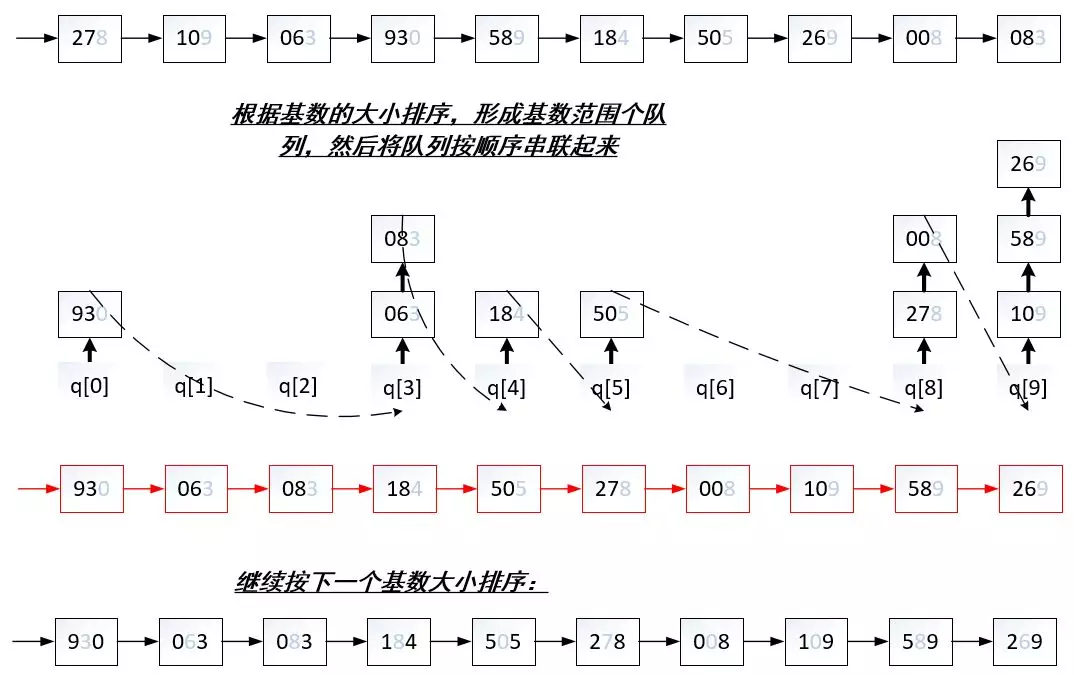
排序时有两点需要注意:
1.每完成一趟排序,要清空队列。
2.队列的连接要找到第一个不为空的队列作为头,和绕开所有空队列。
用Python实现如下:
@staticmethod
def radix_sort(value_list):
"""
基数排序
:param value_list: 待排序的无序列表
:return: 排序后的新列表
"""
i = 0
max_num = max(value_list)
n = len(str(max_num))
while i < n:
# 初始化桶数组
bucket_list = [[] for _ in range(10)]
for x in value_list:
# 找到位置放入桶数组
bucket_list[int(x / (10 ** i)) % 10].append(x)
value_list.clear()
for x in bucket_list:
# 放回原序列
for y in x:
value_list.append(y)
i += 1
sorted_list = value_list
return sorted_list
测试代码:
编写测试代码运行结果如下:
if __name__ == '__main__':
li = list(np.random.randint(1, 1000, 30))
my_sort = MySort()
print("original sequence:", li)
print("*" * 100)
print("1.straight_insertion_sort:", my_sort.straight_insertion_sort(li.copy()))
print("2.shells_sort:", my_sort.shells_sort(li.copy()))
print("3.bubble_sort:", my_sort.bubble_sort(li.copy()))
print("4.quick_sort:", my_sort.quick_sort(li.copy()))
print("5.simple_selection_sort:", my_sort.simple_selection_sort(li.copy()))
print("6.heap_sort:", my_sort.heap_sort(li.copy()))
print("7.merging_sort:", my_sort.merging_sort(li.copy()))
print("8.radix_sort:", my_sort.radix_sort(li.copy()))
测试运行结果:
original sequence: [424, 381, 234, 405, 554, 742, 527, 876, 27, 904, 169, 566, 854, 448, 65, 508, 226, 477, 12, 670, 408, 520, 774, 99, 159, 565, 393, 288, 149, 711]
****************************************************************************************************
1.straight_insertion_sort: [12, 27, 65, 99, 149, 159, 169, 226, 234, 288, 381, 393, 405, 408, 424, 448, 477, 508, 520, 527, 554, 565, 566, 670, 711, 742, 774, 854, 876, 904]
2.shells_sort: [12, 27, 65, 99, 149, 159, 169, 226, 234, 288, 381, 393, 405, 408, 424, 448, 477, 508, 520, 527, 554, 565, 566, 670, 711, 742, 774, 854, 876, 904]
3.bubble_sort: [12, 27, 65, 99, 149, 159, 169, 226, 234, 288, 381, 393, 405, 408, 424, 448, 477, 508, 520, 527, 554, 565, 566, 670, 711, 742, 774, 854, 876, 904]
4.quick_sort: [12, 27, 65, 99, 149, 159, 169, 226, 234, 288, 381, 393, 405, 408, 424, 448, 477, 508, 520, 527, 554, 565, 566, 670, 711, 742, 774, 854, 876, 904]
5.simple_selection_sort: [12, 27, 65, 99, 149, 159, 169, 226, 234, 288, 381, 393, 405, 408, 424, 448, 477, 508, 520, 527, 554, 565, 566, 670, 711, 742, 774, 854, 876, 904]
6.heap_sort: [12, 27, 65, 99, 149, 159, 169, 226, 234, 288, 381, 393, 405, 408, 424, 448, 477, 508, 520, 527, 554, 565, 566, 670, 711, 742, 774, 854, 876, 904]
7.merging_sort: [12, 27, 65, 99, 149, 159, 169, 226, 234, 288, 381, 393, 405, 408, 424, 448, 477, 508, 520, 527, 554, 565, 566, 670, 711, 742, 774, 854, 876, 904]
8.radix_sort: [12, 27, 65, 99, 149, 159, 169, 226, 234, 288, 381, 393, 405, 408, 424, 448, 477, 508, 520, 527, 554, 565, 566, 670, 711, 742, 774, 854, 876, 904]
总结
各个排序效率见下图:

可以得出以下几个结论:
1.从平均时间性能而言,快速排序最佳。
2.堆排序适用于n较大的数据。
3.基数排序是稳定的,时间复杂度较大的简单排序方法也是稳定的。
4.稳定性是由方法本身决定的。
5.没有最好的排序方法,视情况而定。
#! /usr/bin/env python3
# -*- coding:utf-8 -*- # Author : MaYi
# Blog : http://www.cnblogs.com/mayi0312/
# Date : 2020-01-06
# Name : mySort
# Software : PyCharm
# Note : 八大排序算法
import numpy as np class MySort(object):
"""
自定义一个排序的类
""" def straight_insertion_sort(self, value_list):
"""
直接插入排序
:param value_list: 待排序的无序列表
:return: 排序后的列表
"""
return self.__straight_insert(value_list) @staticmethod
def __straight_insert(value_list):
sorted_list = []
sorted_list.append(value_list.pop(0))
for i in range(0, len(value_list)):
tail = True # 是否在尾部插入
insert_loc = 0
for j in range(len(sorted_list)):
if value_list[i] <= sorted_list[j]:
tail = False
insert_loc = j
break
sorted_list.append(value_list[i]) # 先将值插入尾部
if not tail:
# 移动值
for j in range(len(sorted_list) - 1, insert_loc, -1):
sorted_list[j], sorted_list[j - 1] = sorted_list[j - 1], sorted_list[j]
return sorted_list def shells_sort(self, value_list):
"""
希尔排序
:param value_list: 待排序的无序列表
:return: 排序后的列表
"""
gap = len(value_list) // 2
while gap >= 1:
i = 0
while(i + gap) < len(value_list):
start = i
gap_list = []
while start < len(value_list):
gap_list.append(value_list[start])
start = start + gap
gap_list = self.__straight_insert(gap_list)
start = i
while start < len(value_list):
value_list[start] = gap_list.pop(0)
start += gap
i += 1
gap //= 2
sorted_list = value_list
return sorted_list @staticmethod
def bubble_sort(value_list):
"""
冒泡排序
:param value_list: 待排序的无序列表
:return: 排序后的列表
"""
for i in range(len(value_list) - 1):
for j in range(i + 1, len(value_list)):
if value_list[i] > value_list[j]:
value_list[i], value_list[j] = value_list[j], value_list[i]
sorted_list = value_list
return sorted_list def quick_sort(self, value_list):
"""
快速排序
:param value_list: 待排序的无序列表
:return: 排序后的列表
"""
low = 0
high = len(value_list) - 1
self.__qsort(value_list, low, high)
sorted_list = value_list
return sorted_list def __qsort(self, val_list, low, high):
"""
快速排序辅助函数
:param val_list: 无序列表
:param low: 低位
:param high: 高位
:return:
"""
if low >= high:
return
pivot_key = low
temp_low = pivot_key
temp_high = high
while low < high:
# 分成一边比轴(pivot)大,一边比轴(pivot)小的顺序
while low < high:
if val_list[high] < val_list[pivot_key]:
temp = val_list[high]
val_list[high] = val_list[pivot_key]
val_list[pivot_key] = temp
pivot_key = high
break # 发生交换后,就换方向
else:
high -= 1
while low < high:
if val_list[low] > val_list[pivot_key]:
temp = val_list[low]
val_list[low] = val_list[pivot_key]
val_list[pivot_key] = temp
pivot_key = low
break # 发生交换后,就换方向
else:
low += 1
self.__qsort(val_list, temp_low, pivot_key - 1)
self.__qsort(val_list, pivot_key + 1, temp_high) @staticmethod
def simple_selection_sort(value_list):
"""
简单选择排序
:param value_list: 待排序的无序列表
:return: 排序后的列表
"""
for i in range(len(value_list)):
min_val = 9999999
for j in range(i, len(value_list)):
if min_val > value_list[j]:
min_val = value_list[j]
count = 0 # 如果有多个相同的最小值
for j in range(i, len(value_list)):
if min_val == value_list[j]:
value_list[j], value_list[i + count] = value_list[i + count], value_list[j]
sorted_list = value_list
return sorted_list class CldSibNode(object):
"""
私有内部类:孩子兄弟二叉链表节点
""" def __init__(self, val):
self.value = val
self.child = None
self.sibling = None def heap_sort(self, value_list):
"""
堆排序
:param value_list: 待排序的无序列表
:return: 排序后的列表
"""
sorted_list = []
root_node = self.CldSibNode(None)
self.__child_sibling(root_node, value_list, 0)
for ct in range(1, len(value_list) // 2 + 1): # 建堆
self.__adjust_heap(root_node, len(value_list) // 2 + 1 - ct, 1)
for i in range(1, len(value_list) + 1): # 堆排序
sorted_list.append(root_node.value) # 输出堆顶元素
head = root_node
self.__shrink_heap(root_node, len(value_list) + 1 - i, 1, head)
self.__adjust_heap(root_node, 1, 1) # 调整堆 return sorted_list def __child_sibling(self, node, value_list, ind):
"""
创建完全二叉树的左孩子右兄弟二叉链表
:param node: 当前节点
:param value_list: 待排序的无序列表
:param ind:
:return:
"""
if ind >= len(value_list):
return
node.value = value_list[ind]
if ind * 2 + 1 < len(value_list):
node.child = self.CldSibNode(None) # 孩子
self.__child_sibling(node.child, value_list, ind * 2 + 1)
if ind * 2 + 2 < len(value_list):
node.child.sibling = self.CldSibNode(None) # 兄弟
self.__child_sibling(node.child.sibling, value_list, ind * 2 + 2) def __adjust_heap(self, root_node, last_ind, now_ind):
if not root_node or not root_node.child: # 不为空且有孩子
return
if now_ind == last_ind:
# 需要调整的非终端节点
temp = root_node
cg = False
while temp.child:
if temp.value > temp.child.value:
temp.value, temp.child.value = temp.child.value, temp.value
cg = True # 发生交换
if temp.child.sibling:
if temp.value > temp.child.sibling.value:
if cg:
# 如果发生过交换
temp.value, temp.child.value = temp.child.value, temp.value
temp.value, temp.child.sibling.value = temp.child.sibling.value, temp.value
temp = temp.child.sibling
continue
else:
if cg:
# 如果发生过交换
temp = temp.child
continue
break
# 递归
self.__adjust_heap(root_node.child, last_ind, now_ind * 2)
if root_node.child.sibling:
self.__adjust_heap(root_node.child.sibling, last_ind, now_ind * 2 + 1) def __shrink_heap(self, root_node, last_ind, now_ind, head):
if not root_node or now_ind * 2 > last_ind:
# 为空
return
if last_ind == now_ind * 2 + 1:
head.value = root_node.child.sibling.value
root_node.child.sibling = None
return True
if last_ind == now_ind * 2:
head.value = root_node.child.value
root_node.child = None
return True
if root_node.child:
self.__shrink_heap(root_node.child, last_ind, now_ind * 2, head)
self.__shrink_heap(root_node.child.sibling, last_ind, now_ind * 2 + 1, head) @staticmethod
def merging_sort(value_list):
"""
归并排序
:param value_list: 待排序的无序列表
:return: 排序后的新列表
"""
i = 0
while np.power(2, i) < len(value_list):
count = np.power(2, i)
start = 0
outer_temp = []
while start < len(value_list):
# 定位另一边
other = start + count
temp = []
if other >= len(value_list):
# 另一边不存在:直接合并
outer_temp.extend(value_list[start: start + count])
break
left, right = 0, 0
while left < count or right < count:
if other + right >= len(value_list):
# 右边提前结束
temp.extend(value_list[start + left: start + count])
break
elif value_list[start + left] < value_list[other + right]:
# 左边更小
temp.append(value_list[start + left])
left += 1
if left == count:
# 左边遍历结束
temp.extend(value_list[other + right: other + count])
break
else:
# 右边更小
temp.append(value_list[other + right])
right += 1
if right == count:
# 右边遍历结束
temp.extend(value_list[start + left: start + count])
break
outer_temp.extend(temp)
start += count * 2
value_list = outer_temp
i += 1
sorted_list = value_list
return sorted_list @staticmethod
def radix_sort(value_list):
"""
基数排序
:param value_list: 待排序的无序列表
:return: 排序后的新列表
"""
i = 0
max_num = max(value_list)
n = len(str(max_num))
while i < n:
# 初始化桶数组
bucket_list = [[] for _ in range(10)]
for x in value_list:
# 找到位置放入桶数组
bucket_list[int(x / (10 ** i)) % 10].append(x)
value_list.clear()
for x in bucket_list:
# 放回原序列
for y in x:
value_list.append(y)
i += 1
sorted_list = value_list
return sorted_list if __name__ == '__main__':
li = list(np.random.randint(1, 1000, 30))
my_sort = MySort()
print("original sequence:", li)
print("*" * 100)
print("1.straight_insertion_sort:", my_sort.straight_insertion_sort(li.copy()))
print("2.shells_sort:", my_sort.shells_sort(li.copy()))
print("3.bubble_sort:", my_sort.bubble_sort(li.copy()))
print("4.quick_sort:", my_sort.quick_sort(li.copy()))
print("5.simple_selection_sort:", my_sort.simple_selection_sort(li.copy()))
print("6.heap_sort:", my_sort.heap_sort(li.copy()))
print("7.merging_sort:", my_sort.merging_sort(li.copy()))
print("8.radix_sort:", my_sort.radix_sort(li.copy()))
完整代码
最新文章
- Android线程管理之ThreadLocal理解及应用场景
- web前端开发学习内容
- Connecting sql server2008 through C#
- Apache CXF自定义拦截器
- MyDiary,《你的名字。》同款日记应用
- spring hadoop 访问hbase入门
- Swift开发学习-02 变量和常量
- Kafka学习笔记(一):概念介绍
- SQL中添加远程服务器连接
- JavaWeb之Servlet: ServletConfig 与 ServletContext
- iOS - UI - UITextView
- Java学习笔记之:Java 继承
- 直接通过浏览器打开Android App 应用
- Debian安装 ss-qt5
- python3中的一些小改动
- eclipse无法识别Web项目的问题
- 闲聊 Exp/Imp 命令使用
- [MapReduce_8] MapReduce 中的自定义分区实现
- JS 实现 jQuery的$(function(){});
- linux下线刷硬盘